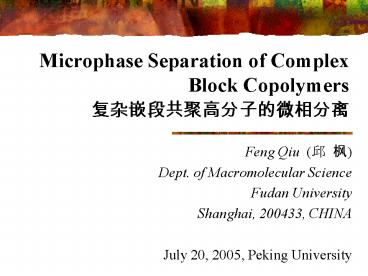Microphase Separation of Complex Block Copolymers ?????????????? - PowerPoint PPT Presentation
1 / 40
Title:
Microphase Separation of Complex Block Copolymers ??????????????
Description:
Block Copolymer ( ) Order-Disorder Transition ( - ) S ~ 1/N Gyroid Phase http://eltweb.mit.edu/images/research/nanostructures ... – PowerPoint PPT presentation
Number of Views:104
Avg rating:3.0/5.0
Title: Microphase Separation of Complex Block Copolymers ??????????????
1
Microphase Separation of Complex Block
Copolymers??????????????
- Feng Qiu (? ?)
- Dept. of Macromolecular Science
- Fudan University
- Shanghai, 200433, CHINA
- July 20, 2005, Peking University
2
Block Copolymer (???????)
3
Order-Disorder Transition (??-????)
- ?S 1/N
Micro-phase separation (????)
4
M. Park, et al., Science, 276, 1401(1997).
5
M. Templin, et al., Science, 278, 1795(1997).
6
Gyroid Phase
- http//eltweb.mit.edu/images/research/nanostructur
es.html
A. H. Scheon, 1960s
7
Diblock Copolymer Morphology
- From M. Matsen
Morphology not sensitive to chain architecture
8
Phase Diagram of Diblock Copolymers
Two parameters f and ?N
Mean Field Theory
M. Matsen and W. Schick, Phys. Rev. Lett, 72,
2660(1994).
9
Complex Block Copolymers
- From G. H. Fredrickson and F. S. Bates
Rich and variety chain architectures
10
Triblock Copolymers (??????)
A
B
C
C
A
B
C
A
B
A
B
C
Chain Architecture
Block Sequence
Parameter space increases 18-fold
11
A Challenge
- Can we effectively predict new morphologies and
their stability? - YES!
- Self-Consistent Field Theory
12
Coarse-graining
The successive coarse-graining processes
13
Chain Modeled as a Path
- q(r,s)
r(N)
r(s)
r(0)
Edwards Model
14
Modified Diffusion Equation for Linear ABC
Triblock Copolymers
0 fAN (fAfB)N N
And initial condition
q similar
15
Free Energy
- Mean field approximation
16
SCF Equations
For linear ABC triblock Copolymers
17
Fourier Space Method
- M. Matsen and W. Schick, PRL, 72, 2660(1994)
Periodic structures Known symmetry
Simplify the problem to matrix operations
18
Phase Diagram of Diblock Copolymers
PS/PI, f0.37 ?N (stable) RL/RG
RHole/RLam Exp. 16-20 2.4 1.02-1.49 Theo.
14.9-20.4 2.45 1.32-1.36
- 60 basis functions
- 10-4, free energy
19
Real Space Method
F. Drolet and G. H. Fredrickson, Phys. Rev.
Lett., 83, 4317(1999).
Initialize all fields randomly
Set ?(r) ?1-? A(r) - ? B(r) - ? C(r)
Solve the diffusion equations for q(r,s) and
q(r,s)
Evaluate ?A(r) , ?B(r) and ?C(r)
Update the potential fields using wAnew wAold
?(?AB?B ?AC?C ?- wAold) wBnew wBold
?(?AB?A ?BC?C ?- wBold) wCnew wCold ?(?BC?B
?AC?A ?- wCold)
20
Pattern Evolution in Iterations
Free energy is lowered and finally reaches
minimum.
21
2D Microphases Discovered in Linear ABC Triblocks
LAM3
HEX
CSH
TET2
22
2D Microphases Discovered in Linear ABC Triblocks
LAMBD-I
HEXBD
LAMBD-II
23
Phase Diagram of ABC Linear Block Copolymer
?ABN ?BCN ?ACN 55
?ABN ?BCN ?ACN 35
24
Influence of Block Sequence
?AB ? ?BC ? ?AC
A
B
C
A
B
C
vs
P. Tang, F. Qiu, H. D. Zhang, Y. L. Yang, Phys.
Rev. E, 69, 031803(2004).
25
Phase Diagram of ABC Linear Block Copolymer
?AB ?BC ? ?AC
A
B
C
A
C
B
26
PI-PS-P2VP and PS-PI-P2VP
S. P. Gido, et al, Macromolecules, 26,
2636(1993).
Y.Mogi, et al, Macromolecules, 27, 6755(1994).
fPSfPIfP2VP?1/3, ?PI-P2VP gtgt ?PS-PI ? ?PS-P2VP
27
2D Microphases Discovered in Star ABC Triblocks
LAM3
TCB
HEX3
LAMBD
28
2D Microphases Discovered in Star ABC Triblocks
KP
HEX
CSH
29
2D Microphases Discovered in Star ABC Triblocks
DEHT
LAMBD-I
30
Phase Diagram of ABC Star Triblock
?AB ?BC ?AC 35
31
Phase Diagram of ABC Star Triblock
?AB ?BC 72, ?AC 22 PS-PI-PMMA
32
PS PI P2VP Star Triblock
- A. Takano et al, Macromolecules, 2004, 37, 9941
33
Influence of Chain Architecture
C
A
B
C
VS
A
B
P. Tang, F. Qiu, H. D. Zhang, Y. L. Yang, J.
Phys. Chem. B, 108, 8434(2004).
34
Phase Diagrams of ABC Triblocks
A
B
C
A
B
C
?AB ?BC ?AC 35
35
3D Structures
A
B
C
36
Conclusions
- For ABC linear triblock copolymers, seven
microphases are found to be stable in 2D. - When volume fractions and interaction energies of
the three species are comparable, lamellar phases
are the most stable phase. - If one of the volume fractions is large,
core-shell hexagonal, or tetragonal phase can be
formed. - As the interaction energies between distinct
blocks become asymmetric, more complex
morphologies occurs. - Block sequence plays a profound role in the
microphase formation.
37
Conclusions
- For ABC star triblock copolymers, nine
microphases are found to be stable in 2D. - When the volume fractions comparable, star
architecture is a strong topological constraint
regulates the geometry of the microphases. - Only when at least one of the volume fractions is
low, the influence of the star architecture is
not significant.
38
Open Questions
- Semi-flexible chains
- Rigid chains
- Dilute solution
- Dynamics ?
39
Acknowledgement
Prof. Yuliang Yang Prof. Hongdong Zhang Dr. Ping
Tang NSF of China Ministry of Science and
Technology Ministry of Education
40
Thank you!































